In honor of much of northern California coming face to face with the Builder’s Remedy, I’m doing this first, ahead of the monthly general roundup. Here we go.
The Federal Option
Biden announces he will hold federal housing funding hostage to the filing of an ‘equity plan.’ It seems he thinks it is within the Executive’s power to do this, requiring all locations to state their ‘fair housing issues’ and what they are going to ‘do about them,’ to ensure desegregation. Enforcement is expected to be, let’s say, tricky.
This sounds to me very much like a claim that the Executive can impose arbitrary requirements on localities if they want to keep these federal funds, or at least arbitrary housing-related requirements that are plausible government interests. So may I suggest we try the requirement of building more housing where people want to live?
The California Option: Enter The Builder’s Remedy
One place they want to live, and can’t because there isn’t enough housing, is California. One way California is trying to change that is through imposing equity requirements cities hate, having cities fail to comply, then triggering the Builder’s Remedy.
This suspends all local zoning laws as long as 20% of units are misallocated or intentionally crippled (officially called ‘affordable’). With one day left to go at the end of last month, most of the Bay Area (although not SF proper) was slated to fail, potentially allowing developers to shoehorn in new construction the way they did in Santa Monica. Cities can get their zoning laws back by complying, but anything approved in the meantime will stay approved.
There was at least some window in quite a lot of the Bay:
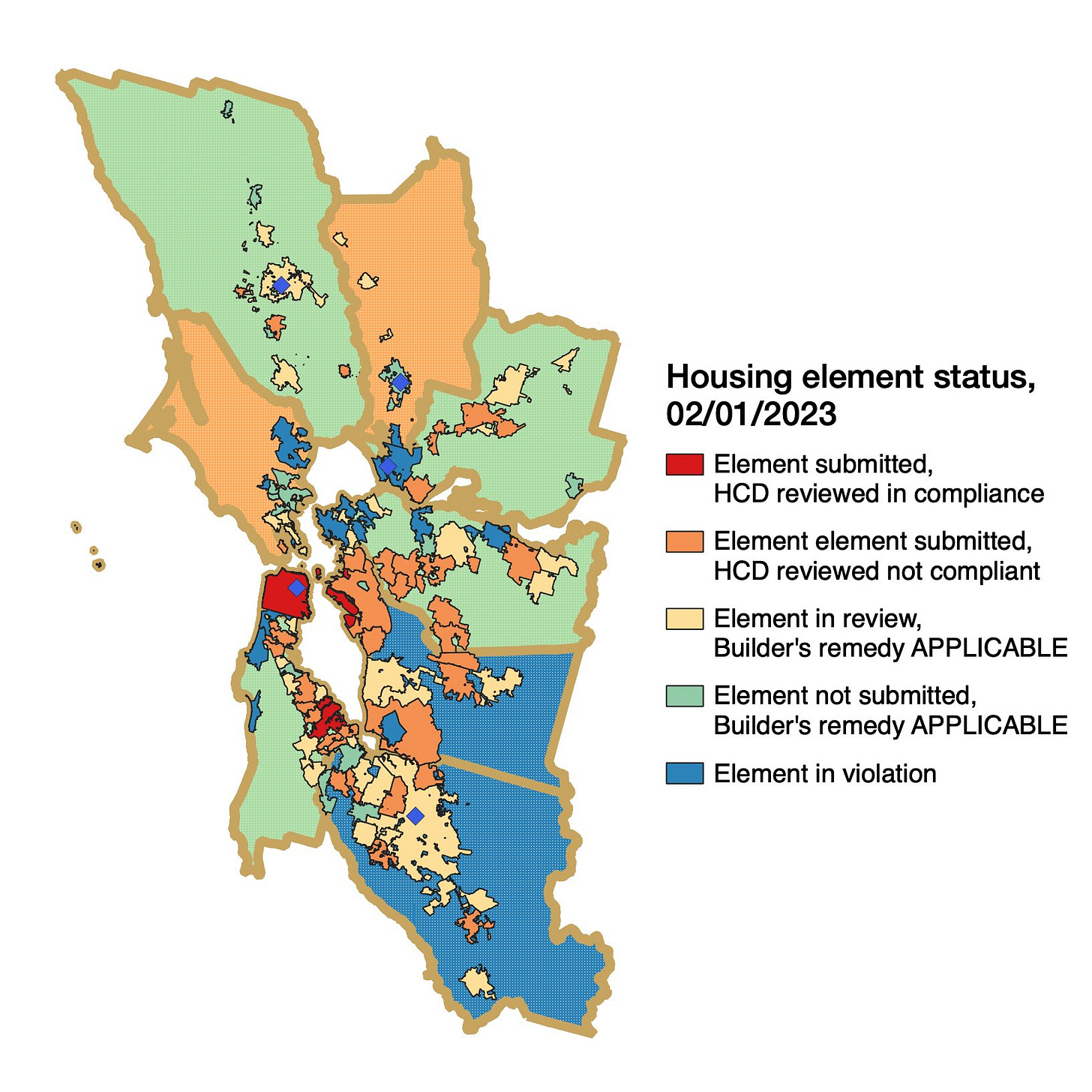
Here’s the same thing in list form.
What struck me most about Santa Monica was that there wasn’t way more new construction approved on the first day. There is huge pent up additional demand for places like Santa Monica, or now Berkeley. Building a lot more housing would drive down rents somewhat, but not to anything like reasonable levels unless it was truly massive. If it was truly massive, and suddenly there were hundred of thousands of new apartments going up, then as long as city services were able to scale up to match rather than intentionally sabotaged the result would be a new city and plenty of wealthy real estate developers. It likely would even benefit current property holders, in terms of wealth, as their house gets less valuable but the land under it skyrockets.
If I was a real estate developer, at least once I saw Santa Monica, I don’t know how fast I could develop a viable plan, but if I could I would have one (or more!) queued up and ready to go in every city, with an option to buy the land, so I would have been able to submit the most massive structure that was safe and commercially sensible to build at 9am on February 1, 2023 if any city slipped for even a day. Go big and build home.
If it’s not too late by the time you read this, here’s some help on getting that application in quickly.
It is important here not to let the perfect be the enemy of the good. Speed premiums are rarely higher. Returns to scale are the key. Any generic apartment building will do, if you don’t have anything better queued up, even if you can’t change it later. Worst case, you can ‘take a buyout’ of sorts and scale back later.
I often say The Efficient Market Hypothesis is False. This is a prime example.
The New York City Options
Governor Hochul of New York proposes a similar regime to those in California and New Jersey, where if areas do not grow their housing stock by 1% over three years, or for NYC and the surrounding area (which is half the state) 3% over three years, developers can bypass local zoning laws and instead get approved by the state, which would pretty much approve anything with substantial affordable housing in it.
Mark Levine, Borough President of Manhattan, releases plan for 73k new homes (plan, 88pp).

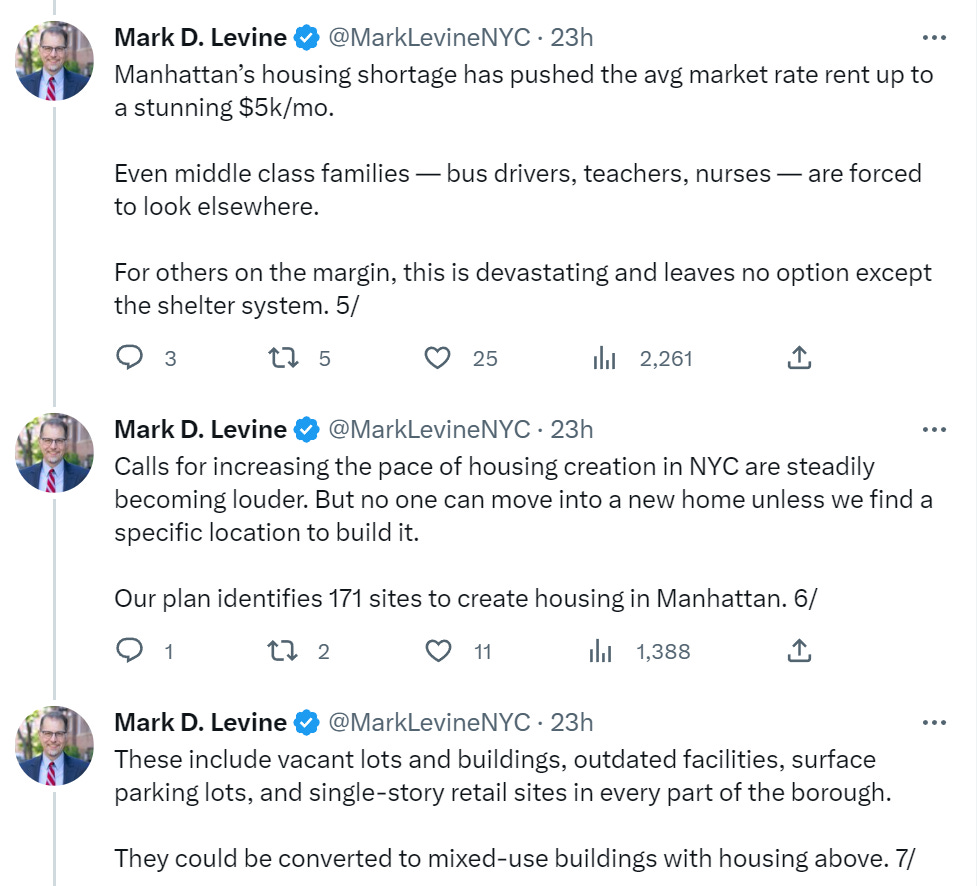

I am all for all of this. It is telling that the government has to figure out where building is going to be permitted.
The bad news is that this ‘builder’s remedy’ has yet to be successfully used in California, because local governments there are still in charge of permitting projects, which they then decline to do. I mean, no, but man, so much good stuff here:
Hochul’s proposal tries to avoid this dynamic by cutting local governments out of the process entirely. That would, in theory, afford the state’s NIMBYs, and local governments they control, no direct ability to stop new housing. Localities could still raise health and safety objections, but those would have to be vetted by the proposed new board.
…
The governor’s idea of targeting overall housing growth is also simpler and more rational than California’s equivalent system, whereby the state calculates local housing needs by income level and then gives local governments goals of how much low-, moderate-, and market-rate housing they should be building.
I share largely because I find it fun and it seems to be in good faith: Cubed article by Lane Brown blames high New York City rents on apartments being held intentionally vacant to hold out for higher rents, a process called ‘warehousing,’ that he believes is a monopolistic conspiracy coordinated by pricing software despite having no enforcement mechanism. So much good stuff here.
This was how I became aware of “warehousing,” the practice by which landlords keep unrented apartments off the market to create artificial scarcity. Building owners have always done this, especially in new constructions with lots of virgin inventory, because why give renters the upper hand if they don’t have to?
But they really started doing it during the pandemic. On a 2022 episode of the real-estate-industry podcast Talking Manhattan, Gary Malin, COO of the Corcoran Group, made a surprising claim: “At one point during the downturn, the vacancy rate in the city was close to 25 percent,” he said. “You had owners who were sitting on hundreds if not thousands of empty apartments.”
Officially, during the peak of the COVID exodus, the vacancy rate in Manhattan was 4.3 percent, the highest in at least 14 years. But those “official” vacancy rates we hear so much about are sourced from market reports by brokerage firms like Corcoran and Douglas Elliman, and they only reflect the number of rentable apartments that landlords are advertising, not the number that actually sit empty.
…
We know that at least 20,000 rent-stabilized apartments are being warehoused because landlords have admitted as much. (A 2021 Census Bureau estimate puts the number at 42,860.) Owners blame a 2019 state law, the Housing Stability and Tenant Protection Act, which limits the amount they can raise rents to pay for renovations. They say their warehoused apartments are in such poor shape that it would be impossible to recoup the cost of necessary repairs at rent-stabilized prices, so they’re holding them vacant until Albany repeals the law.
…
I have no proof that apartments in these towers are being warehoused and acknowledge that such a thing may seem counterintuitive in today’s allegedly red-hot market — or any market. But if demand for expensive units is softer than we’ve been led to believe, I wonder if landlords could be hiding supply to keep their rents up. Why not just list all of their vacant apartments, even if that depressed prices, since collecting some rent is better than collecting none at all? Maybe because owners take out large loans to develop these buildings, and their lender agreements often require that they charge minimum amounts.
…
But here, I admit, is where my conspiracy theory falls apart: If all of these luxury buildings were hiding supply, wouldn’t one smart landlord undercut competitors by opening their whole stock and making a killing at today’s artificially inflated prices? Of course one would. And so I almost ended this column with a deeply felt apology for impugning the honest intentions of the New York City real-estate community.
But then, in October, ProPublica published what seemed like evidence of an actual conspiracy. It turns out that some landlords have been using the same software to do some very interesting things.
The app is RealPage Revenue Management Software, it’s made by the Texas-based company RealPage, and allegedly it works by collecting private pricing and inventory stats from competing building owners and then using that data to give them each recommendations for how to price their available apartments such that nobody undercuts the others.
…
Landlords are allowed to reject RealPage’s pricing guidance, although former employees of the company told ProPublica that up to 90 percent of suggestions are followed. The software discourages negotiation with tenants and has even been known to tell owners to goose prices by holding back supply.
On a 2017 earnings call, RealPage CEO Steve Winn described how a property manager saw revenues go up when their buildings that had historically been 97 or 98 percent full cleared out to 95 percent, “an occupancy level that would have made management uncomfortable before.” According to one lawsuit, “This is a central mantra of RealPage, to sacrifice ‘physical’ occupancy in exchange for ‘economic’ occupancy, a manufactured term RealPage uses to refer to increasing prices and decreasing occupancy in the market.”
Let’s appreciate that this (mostly) accepts the basic premise that prices are set by supply and demand. The reason apartment prices in NYC are high is that there are not enough apartments.
Why aren’t people moving back to NYC in excess of 2019 levels? Because there are no extra apartments for them to rent, so the increased demand manifests as higher prices. The question then is why there aren’t more apartments available.
Why doesn’t the change in demand cause increased supply of rent-stabilized apartments? Because there are only so many of them, and some of them are being held vacant. The landlords claim this is because it would lose them money to rent the places out. Given the landlords are profit maximizing I see no reason to doubt their claims here. Sounds like a regulatory error. Either tighten the requirements and seize the private property outright like good honest stationary bandits, or change the rules to make the economics work.
Why doesn’t the change in demand cause increased supply of market-rent apartments?
In reality, mostly because of the legal barriers to building more, including the delays involved, although fixing a surge in demand would still take years. Brown’s model clearly thinks building more apartments would, if allowed with only moderate bribery and extraction involved, be highly profitable. Not that this is mentioned at all.
In Brown’s model primarily, and in reality a non-zero amount, because sometimes landlords choose not to rent, and Brown is proposing that there exists a massive amount of inventory being held back in a conspiracy to drive up prices. Somehow a price estimator called RealPage, used by 1.8% of NYC rental apartments, holds this all together. I mean, no. Of course not, that is completely insane. In a rental market where listings get lines out the door to see them, who is going to listen to a piece of software (that they mostly don’t even use) and hold back renting out places?
The core thing going on is that RealPage is both giving a better perspective on the state of the market, and offering a better path to optimizing profits on rentals via accepting a small amount of vacancy.
These go together. If you do not know the right price to charge to clear the market, you cannot afford to ‘hold out’ for a while to get that price, because you might be holding out for a price that is too high and wait for a very long time. Nor will you know how to adjust the price as conditions change. Holding inventory for a while does not make sense for you, so if you don’t rent within a short window, you should slash your asking price.
However, if you do have good calibration and adjustment of prices, including seasonal and expected future adjustments, then you are in much less of a hurry. A short window of holding out gets you higher prices, which eventually means higher profits. The same goes for raising rents on existing renters. If you know what they are likely to stomach, and you are better equipped to handle them moving out, you can be more aggressive. That won’t spill over into the broader market by more than a fixed percent unless my model is wrong.
The idea that one would hold back inventory in order to prop up the overall market only possibly makes sense in completely new buildings, or otherwise have a ton of vacancies, where seeing all the available units could drive people away or cause them to try to negotiate for lower rents. Also note that this doesn’t do anything to actual supply – if I list 10 identical units instead of 100, and then when I rent those 10 I release 10 more, nothing has changed. If something would change, it would hurt my bottom line in order to help… other landlords a tiny amount? Why would I do that?
For market housing, we are talking about at most 2%-3% of apartments being vacant at any one time. That could indeed have a modest impact on rents. Imagine what building more apartment buildings would do. There is also another modest effect where landlords don’t underprice, which also raises rents a bit I suppose. This could perhaps be a few percent.
Here is another source for there being over 60,000 NYC apartments sitting vacant because it costs more money to bring them up to code and maintain them than they would be allowed to charge in rent. This is framed as ‘holding them for ransom.’
Yes, we won’t release the apartments unless you come up with at least zero dollars.
Here’s a weirdly framed article from The New York Post: How Extreme Rent Rules Deepen NYC’s housing crisis. The central point here is that 30% of rent-stabilized apartments are being rented below their maximum rate. And That’s Terrible. It is terrible because the tenants don’t understand that the rent limit has no impact, and thus support rent stabilization. They then briefly make a standard (correct) case that rent control is bad and we should limit or remove rent controls.
How much are rent controlled apartments worth? From August, state is probing $19,500 broker fee on a $1725/month one bedroom in Manhattan. Seems high. Law says it can’t be ‘exorbitant’ in a way that ‘has no reasonable relationship to the work involved.’ Let me tell you, if I owned a rent controlled apartment like that, I’d make the broker work very hard.
From the perspective of the value of the lease, seems way too low. Tenant will be in the black by year two.
What If Construction Raises Rents?
Tyler Cowen and Matt Yglesias ask, does more construction raise rates?
Or rather, Matt asks what follows from that. Huge if true.

Once stated that way, the proof is obvious. In a better world it would be left as an exercise for the reader.
You’d be saying, in essence, that a new building would generate more demand than supply, which if taken really literally suggests that cities can unleash a kind of perpetual motion machine for economic growth, where supply begets demand which begets supply which begets even more demand. That seems like it’s probably false — but more importantly, if it’s true, that seems like something we’d want to know about!
Some sources in further discussion include Jerusalem Demsas saying skeptics are confusing cause and effect, and Kate Pennington looking at buildings rebuilt after fires in San Francisco and finding rents and displacement fall near market-rate projects.
It all also demonstrates that the causal mechanism where new construction raises rents is that it causes life to be better. Which implies that we should prevent life from being better.
As Matt puts it:
- Don’t renovate the crummy playground because a nice new playground will make the neighborhood better, raise demand, and lead to higher rents.
- Don’t recruit and retain excellent teachers at the neighborhood middle school because rising test scores will raise demand for living in the neighborhood and lead to higher rents.
- Don’t solve murders that happen on the neighborhood’s commercial street because solving crimes will deter shooters, make people feel safer, and lead to higher rents.
Even more than that, make life worse. That will lower rents.
There are two valid models. In one, making life better is good. In the other, low rent is more important than everything else, so making life better is bad and making life worse is good. There are, indeed, plenty of places where life is much worse and therefore rent is much lower. One could move to them, if one wanted. The not wanting to is why the rent is low.
Tyler extends this by considering the scenario where NYC builds tons of housing, noting that analysis suggests you need to build quite a lot to get much fall in rents, and says that landlords get a lot of the gains. Which, as he notes, is fine. They are still gains. If they weren’t gains, landlords would not net benefit.
These analyses always seem like they need to focus more on the fact that many people get massive additional surplus from the housing they consume. Residents are not all similar, and many are cash constrained, and these have odd effects on what happens that are worth thinking more about in ways I have not seen anyone do yet, myself included.
The Wrong Person Might Buy It
A reason it is good to build more houses where people want to live is that you then don’t have to then prevent the wrong people from buying them.
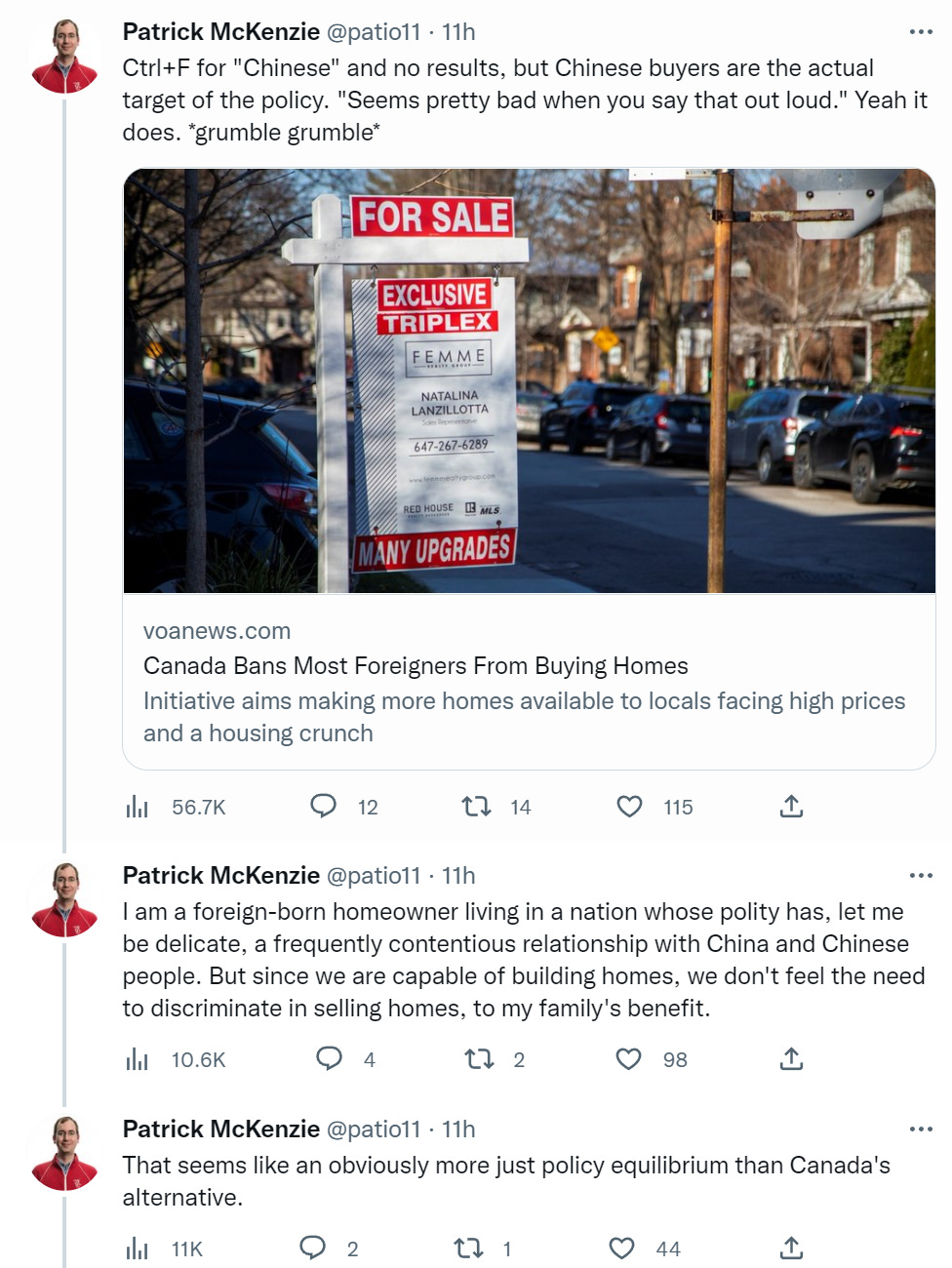


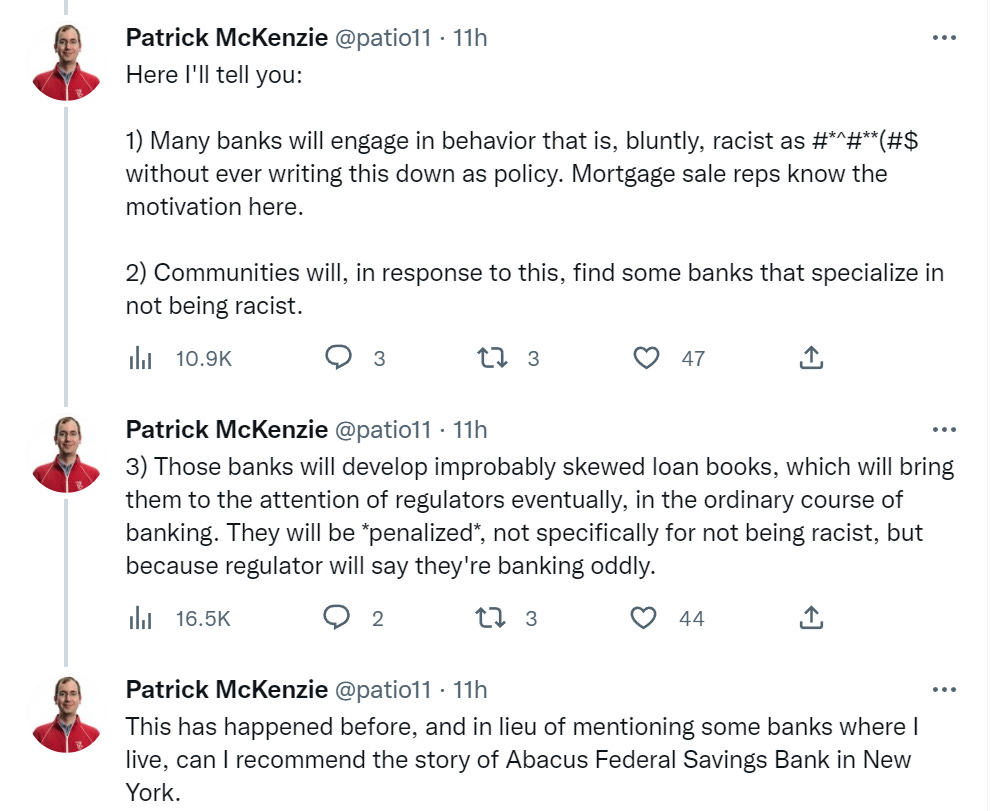
On the opposite end of the spectrum, hedge funds.

If enough hedge funds buy up enough homes, perhaps we will be more willing to build more houses where people want to live.
How much leverage do Fannie and Freddie have over the housing market? Quite a lot. This CNN post from April 2022 chronicles some of the difficulties that arose when they imposed additional requirements on mortgage purchases in the wake of the condo collapse in Miami. Essentially, they required it be documented that the reserve funds were in good condition and all necessary repairs completed, and the legal implications of this meant a lot of associations refused to fill out the required forms. That leaves buyers with the options of taking a higher interest loan from someone prepared to hold the mortgage, or paying cash. Presumably this lowers the apartment value and purchase price.
Bloomberg notices that rents have fell by ~3% in Q4 2022, frames this as a bad thing. Warns of the dangers of a ‘hard landing.’
And while tenants will cheer this possibility, the worry is that it will destroy the pipeline of new supply for years to come.
…
Ominously for the rental market, it isn’t clear that developers and investors are prepared for a period of softness. The national apartment vacancy rate rose to 5.9% in December, its highest level since April 2021, and has been rising by 0.2% a month recently, according to Apartment List. At that pace the vacancy rate would be at its pre-pandemic level by April.
All this is happening while there are more apartment units under construction than there have been in more than 50 years, which will dump even more supply onto the market.
This is blamed in part on a decline in ‘household formation,’ especially of the famed single-person household, now that the pandemic is over. This is good news. It is good that housing construction is adjusting back to creating the types of places that match demand.
‘I’ve seen gluts that weren’t followed by shortages, but I’ve never seen a shortage that wasn’t followed by a glut.’
One can only hope.
This won’t much stop construction in the places we most need construction. And, of course, this is all great news, the whole point of constructing new housing is that people get to live where they want to and rents go down. Same thing with home prices, if they decline due to remotely sufficient supply that is your best possible situation.
Public Transit
Public transit journeys stabilizing 35% below 2019 levels.
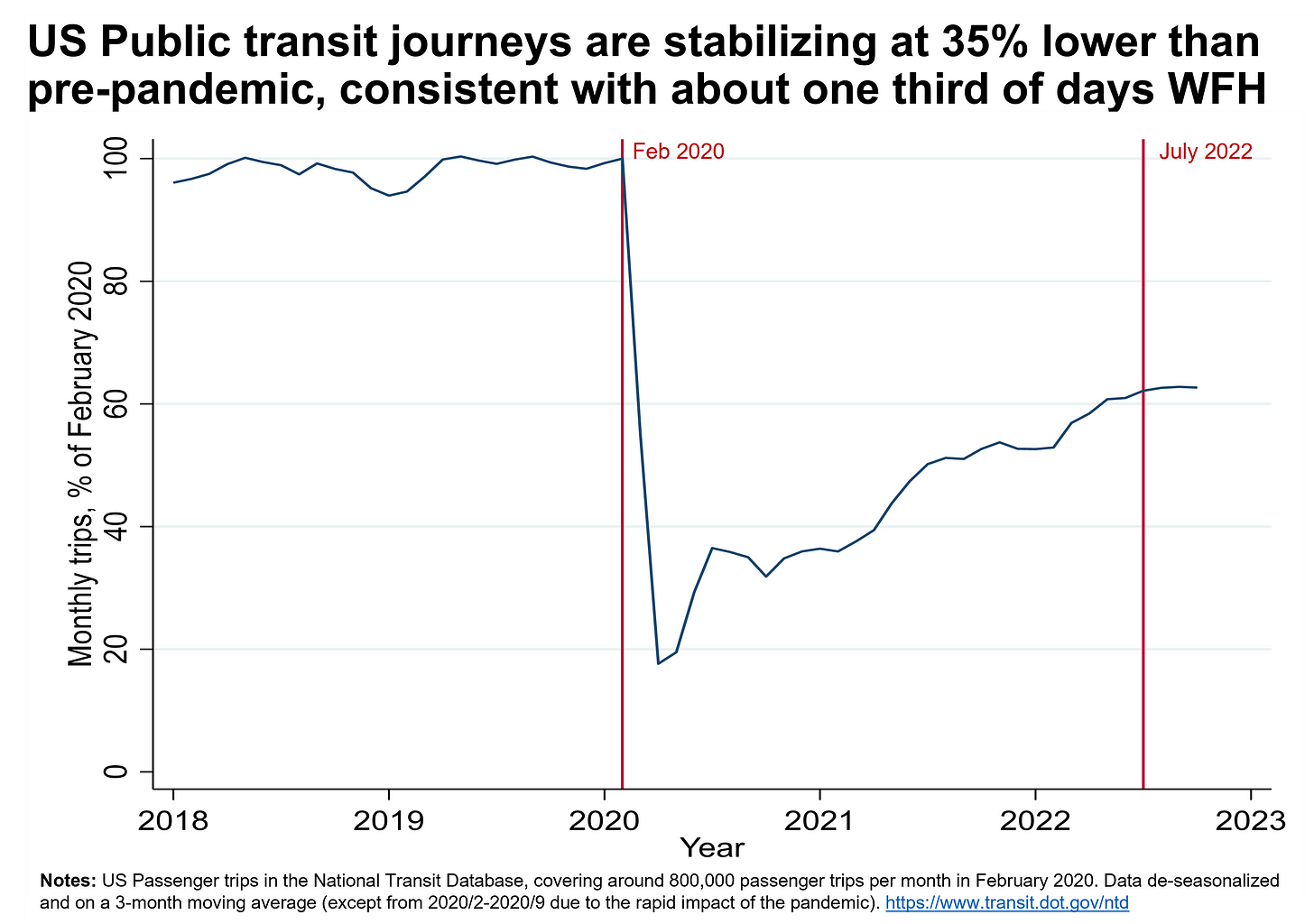
This is a problem for services supported by rider fees.
How much of a problem is it in terms of the transit lines justifying their existence on value terms? My guess is almost none for existing lines. Once people orient around an existing public transit system, the value they get on the margin from it continuing to exist is immense. The value of a train or bus ride is usually many times the cost of riding, and the costs of adjustment if they were suddenly unavailable would be immense.
When we expect public transit to pay for itself, and consider it a failure if it does not, we ignore the massive consumer surplus, the massive increased value of land and the massive impact on traffic, or the optionality and lifestyle and general zeitgeist changes.
That could all be cancelled out by massive construction costs, but that does not apply to buses or to existing train lines.
What happens when your agency tasked with constructing public transit brags about imposing high costs on building public transit?

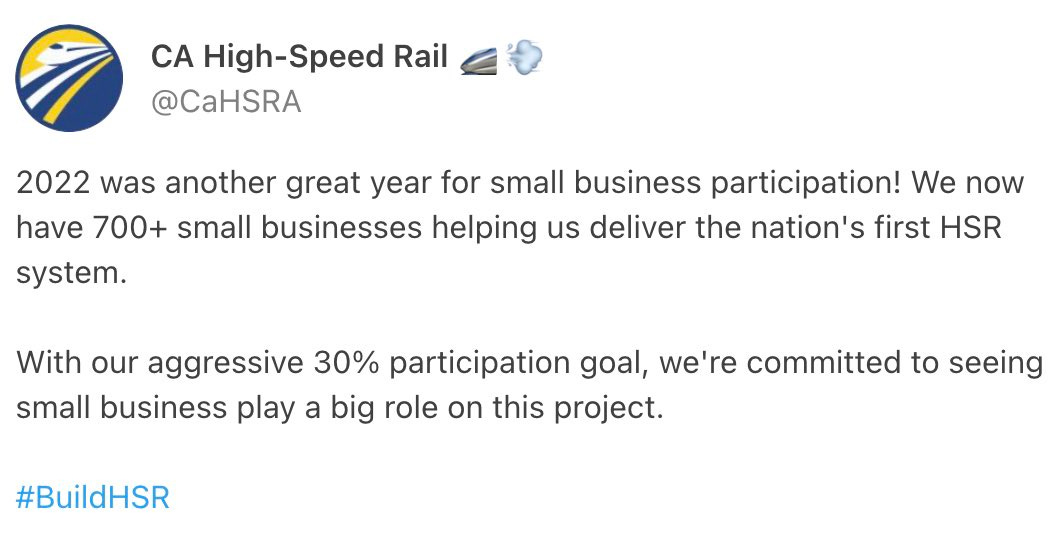
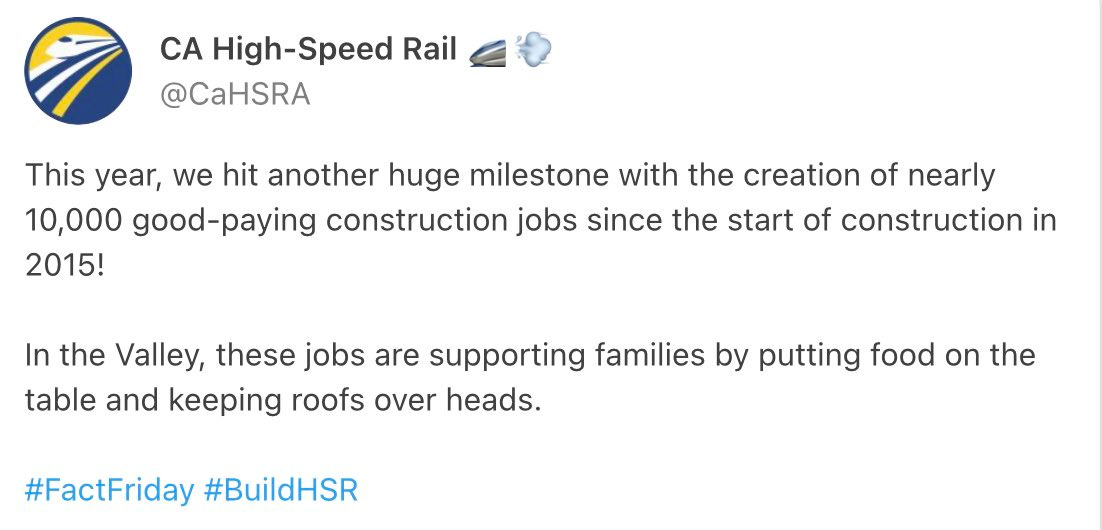
Jobs are not primarily a benefit. Jobs are a cost. They mean people are spending time. They mean you are paying them for doing so.
Matt Yglesias argues that American transit agencies should prioritize ridership over other goals.
(He also links to this explanation of why the Second Avenue Subway was so expensive.)
I would divide this into two categories.
There is the ridership versus coverage tradeoff, questions like ‘do you have more buses on the most used lines or do you ensure there are more bus lines that cover more places?’ and ‘how much do you favor express versus local lines?’ Then there are questions of ridership versus ‘does this station look nice and have the proper concessions?’ or other things that don’t involve much helping people get from Point A to Point B.
For that second category, violent agreement. Prioritize ridership. Only care about providing a Starbucks to the extent it increases ridership. Otherwise everyone can use the one two blocks away. It’s fine.
For the first category the question is what creates the most value. I think both coverage and ridership create a lot of value.
The danger with buses, as I see it, is providing coverage that is too good where you don’t need it. When I lived in Warwick, there was a bus that could take us into New York City that came every 30 minutes or so. This was highly valuable. However, except at rush hour, the bus was mostly empty. If that bus had mostly come every 60 minutes instead, how much of the value would have been retained? My guess is at least 90%. It would have made it much more painful to miss the bus, and require a bit more planning, but the key question was ‘can I get from A to B and back to A?’ and the answer would remain yes.
There is a phase change where the bus plan goes from ‘show up and wait for the next one’ to ‘plan to catch the X:00 bus’ and one should think a bit about crossing over that line, but once you are making a plan you’re pretty much good.
What I wouldn’t want to do is stop running the only bus, even if it wasn’t that full. The people who ride that bus will often get a lot of value from that bus, as in ‘can live in this town because the bus exists’ kinds of value. It changes the entire character and geography of the area.
The express versus local dilemma I mostly am in favor of more express and less stops on the margin. I think that the little extra time walking is mostly more than made up for by faster travel and more frequent service. And on the most used lines, seems easy to add more buses until the buses are well below capacity, the speed and experience gains seem clearly worthwhile.
Trains are tougher since they are less flexible. Once again, I think a barbell strategy is in order. A train either is trying to have a lot of riders or it is trying to provide a unique service for those few who get a lot of value from it, and who thus can afford to plan around it. I do think that Amtrack building out more train lines changes geography and dynamics in important ways even when ridership is not so high. I would prioritize that far more than the ridership numbers would suggest.
I’d still say the central focus should be squarely on the NEC, where tons of value is being left on the table. The gains from making the NEC faster, cheaper, higher capacity and more pleasant are very large.
The simplicity argument also matters. Having a single clean target is much easier than having two. Once you have two it’s easy to suddenly have three, then many. I would happily take ‘maximize ridership’ and toss out coverage entirely, if that got rid of all or most of the other considerations as well.
He also pointed to this Jedwin Mok thread describing mass transit in Canada, where buses and trains come every five minutes and transfers and connections are planned out carefully and work well in practice, so the offered transit lines are actually used.
Helen Andrews counts 40 fare jumpers within five minutes, up from 22 last time. Someone enforcing the rule could do some combination of earn a very high hourly for the city through fines alone or earn a very high hourly for the city through forcing people to pay their fare. Given the choice to do neither, this seems like a conscious decision to allow the Metro to be free. I would respect that choice.
The Joy of Traffic
Matt Yglesias points out that when you expand a highway or other road, and this causes more people to drive on it, that means more people are using the road and that should be presumed to be something they benefit from and want to do, so it is good.
The new trips either (A) replace other trips, which frees up traffic elsewhere and improves the trip (or else why shift) or (B) are new trips that people want to take. If you think that such trips have negative externalities, we have tolls and gasoline taxes available to fix that, which also might help with traffic (although badly executed tolls can make it worse.)
The whole induced demand thing is kind of weird, at least in terms of magnitude. Suppose you have a 3-lane highway, and you double it to a 6-lane highway with twice the capacity, and traffic does not improve at all. That’s super weird, right? The highway is equally terrible now as it was before, yet twice as many people choose to use it simply because it is bigger? Something has gone very wrong somewhere.
I’ve read the Wikipedia article on the phenomenon and the piece in Wired and seen the study results, and they imply very strange things. If a 10% increase in capacity within a few years creates a 10% increase in utilization, then that means there is essentially boundless long term demand for the road at that level of traffic.
If that is true, and the marginal car does not much change the traffic situation, why isn’t there boundless demand for the road with slightly worse traffic, increasing congestion now? If reducing capacity reduces utilization without harming traffic, how is that possible unless the experience of those still using the road got worse some other way? What is happening?